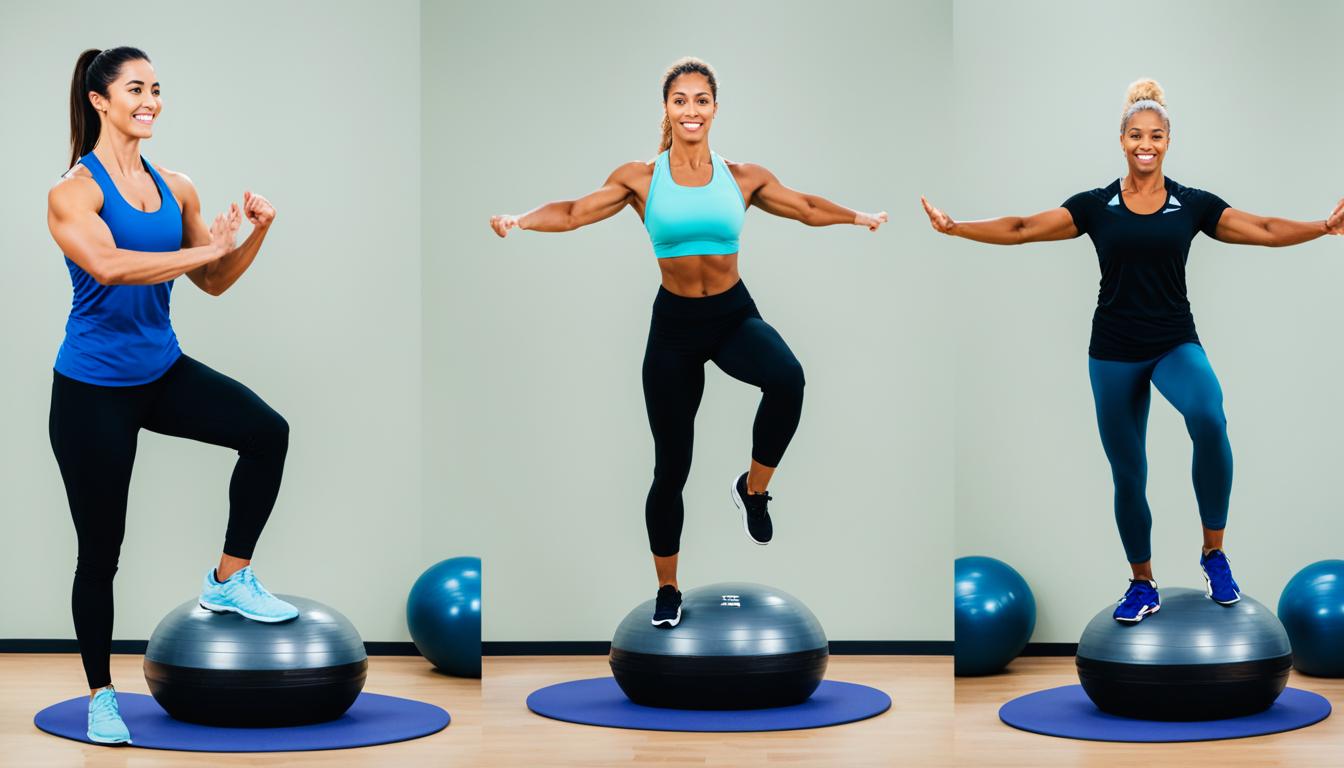Balance training is more than just standing on one foot—it is a vital component of overall health and well-being. Not only does it help prevent injuries, but it also plays a significant role in predicting longevity. In fact, a study showed that individuals who couldn’t maintain their balance on one foot for a 10-second count were twice as likely to die within the next 10 years.
Balance and stability are essential in many aspects of life, from everyday activities to sports and fitness routines. However, simply sitting on a stability ball or standing on a BOSU ball may not effectively improve your balance. Strength training, on the other hand, can significantly enhance your balance and stability by improving your proprioceptive awareness, spatial awareness, and overall strength. This virtuous circle of balance and stability leading to improved strength and vice versa is crucial for proper movement and injury prevention.
When it comes to balance training, there is a wide range of exercises, techniques, and equipment to choose from. Whether you prefer core-focused exercises or specific balance workouts, there is something for everyone. By incorporating balance training into your fitness routine, you can unlock a multitude of benefits and take your overall performance to new heights.
Key Takeaways:
- Balance training is essential for overall stability and well-being.
- Improving your balance can help prevent injuries and predict longevity.
- Strength training plays a crucial role in enhancing balance and stability.
- There is a wide range of exercises, techniques, and equipment for balance training.
- By incorporating balance training into your routine, you can unlock numerous benefits and enhance your overall performance.
The Benefits of Balance Improving Exercises
Engaging in balance improving exercises brings a multitude of benefits. These exercises are not only about staying upright, but they also have a significant impact on your overall well-being. By incorporating balance training into your routine, you can enjoy improved stability, decreased likelihood of falls, and even improved mortality.
One of the primary benefits of balance training is improved stability. When you train your balance, you enhance your ability to maintain control of your body in various situations and positions. This heightened stability not only helps you prevent falls and accidents but also enhances your overall performance in sports, everyday activities, and exercise routines. By developing better balance, you’ll be able to move with confidence and ease.
Balance training also plays a crucial role in improving your equilibrium and spatial awareness. Through specific exercises that challenge your balance, you’ll enhance your body’s proprioceptive awareness and improve your ability to maintain balance even in challenging situations or during dynamic movements. This increased awareness and equilibrium can significantly contribute to your athleticism, making you more agile and efficient in your movements.
Moreover, balance training helps correct muscle imbalances, which are common in individuals who engage in repetitive or one-sided activities. Imbalances can lead to poor posture, reduced range of motion, and an increased risk of injuries. By incorporating balance improving exercises into your routine, you can correct these imbalances, strengthen weaker muscles, and achieve optimal muscle coordination and balance.
Another significant benefit of balance training is the improvement of overall strength. When you challenge your balance, you engage your muscles in a unique way, requiring them to work harder to maintain stability. This increased demand leads to muscle growth and strength development, which is essential not only for balance but also for compound lifts and functional movements in everyday life.
By training for balance, you are not only improving your physical abilities, but you are also enhancing your mental map. Balancing exercises force you to engage your mind and focus on the present moment, improving your concentration and mindfulness. This mental clarity can extend beyond your workout sessions, positively impacting various areas of your life.

10 Balance Improving Exercises
To improve your balance, incorporate the following 10 exercises into your routine:
Box Step-Up with Knee Drive
The box step-up with knee drive is an excellent exercise for challenging your balance while strengthening your hips and thighs.
Single-Leg Romanian Deadlift
The single-leg Romanian deadlift targets your balance, stability, and hamstring strength, helping you improve overall lower-body control.
Lateral Lunge
The lateral lunge is beneficial for building coordination, stability, and injury prevention for lateral movements. It enhances your ability to move side to side with balance and control.
Around the Clock
The around the clock exercise enhances balance and stability by challenging you to move around on one foot in a circular motion. This exercise improves your ability to control your body’s position in space.
Plank with Shoulder Tap
The plank with shoulder tap is a core-strengthening exercise that also improves shoulder and hip stability. It challenges your balance by requiring you to lift one hand off the ground while maintaining a stable plank position.
Cable Single-Arm Row
The cable single-arm row focuses on balance and stability while engaging your back muscles. Pulling the weight while maintaining proper form challenges your core and improves your overall body control.
Single-Leg Squat to a Chair
The single-leg squat to a chair exercise develops balance, stability, and leg strength. By performing a controlled squat on one leg, you improve your ability to stabilize your body during movements.
Bodyweight Squat Jump
The bodyweight squat jump is a powerful exercise that enhances explosiveness, coordination, and balance. By incorporating jumps into your routine, you train your body to generate force and stabilize efficiently.
Try incorporating these balance improving exercises into your workout routine to enhance your stability, coordination, and overall body control. Remember to start with proper form and progress gradually as you improve.

Understanding Balance Training for Athletes
Balance training is crucial for athletes as it helps you maintain control of your body in space. There are three types of balance: static balance, semi-static balance, and dynamic balance.
Static balance involves maintaining control on a stable surface, such as standing on one leg or holding a yoga pose. It requires concentration and stability to stay balanced without any external movement.
Semi-static balance, on the other hand, involves maintaining the same position on a moving or unstable surface. This could include exercises like standing on a wobble board or balancing on a stability ball. It requires you to adjust your position and engage your muscles to stay balanced while the surface moves.
Dynamic balance involves constantly changing positions and surfaces. This type of balance is essential for athletes who need to switch direction quickly or adapt to uneven terrain. It requires a combination of strength, coordination, and proprioception.
Athletes need to develop advanced balance control in all three types of balance to enhance their overall athleticism and performance. By incorporating balance training into your strength and conditioning programs, you can improve your stability, agility, and coordination.
Balance training has become an integral part of strength and conditioning programs at all levels of sports. It allows athletes to perform at their best and reduce the risk of injuries by improving their ability to maintain optimal body control and stability.
Whether you are a professional athlete or just someone who enjoys staying active, incorporating balance training into your fitness routine can enhance your overall athletic performance and improve your ability to perform daily activities with ease and confidence.
The Science of Balance Training for Athletics
Balancing training for athletics is rooted in the science of proprioception, which encompasses the body’s ability to perceive and understand its position in space. It relies on three primary sensory components: the eyes, the vestibular system, and the somatosensory system. Each of these elements plays a vital role in the effectiveness of balance training exercises.
The eyes serve as an important source of input, providing information about our body’s position relative to the surroundings. By honing our visual awareness through balance exercises, athletes can improve their proprioceptive abilities and enhance their overall stability.
The vestibular system, located in the inner ear, contributes significantly to balance and spatial perception. It sends signals to the brain about head movements, linear acceleration, and rotational motion, enabling us to maintain equilibrium during dynamic activities. Through targeted balance training, athletes can enhance the functioning of their vestibular system, leading to improved stability and agility.
Moreover, the somatosensory system, consisting of sensory receptors in the muscles, joints, and skin, plays a crucial role in providing information about the environment and the body’s position within it. By engaging in balance exercises, athletes can enhance their somatosensory feedback, allowing for better coordination, motor control, and body awareness.

By incorporating balance training exercises into an athlete’s workout routine, they can reap various benefits. These exercises improve neuromuscular control, reduce the risk of injuries, strengthen core muscles, and enhance overall sports performance. The science of balance training brings about positive effects on an athlete’s proprioceptive abilities, ultimately leading to improved stability, coordination, and agility.
Understanding the science behind balance training empowers athletes to optimize their training regimens, unlocking their full potential on the field or court. By enhancing proprioception through targeted exercises that engage the eyes, vestibular system, and somatosensory system, athletes can achieve remarkable improvements in their athleticism and performance.
Conclusion
Balance training is not just for athletes but for individuals looking to improve their stability and overall well-being. By incorporating balance improving exercises into your routine, you can decrease the likelihood of falls and accidents, improve your mortality, enhance equilibrium and spatial awareness, correct muscle imbalances, build overall strength, improve posture, increase range of motion, enhance proprioception, prevent injuries, enhance performance, and improve quality of life.
Whether you’re an athlete or simply want to live an active lifestyle, balance training is a valuable component of your fitness journey. It offers a wide array of benefits that go beyond just physical strength and stability. By challenging your balance, you are not only strengthening your body but also improving your mind-body connection and coordination.
So don’t wait any longer, start training for balance and stability today and experience the numerous benefits it brings. Incorporate balance improving exercises into your workouts, such as the box step-up with knee drive, single-leg Romanian deadlift, and lateral lunge, among others. Balance training will not only improve your performance in sports and everyday activities but also contribute to your overall well-being.
FAQ
What is balance training?
Balance training is a form of exercise that focuses on improving stability and equilibrium. It involves performing specific exercises and movements that challenge your body’s ability to maintain control and balance.
What are the benefits of balance improving exercises?
Balance improving exercises offer a range of benefits, including improved stability, decreased likelihood of falls, improved mortality, enhanced equilibrium, increased athleticism, correction of muscle imbalances, and overall strength.
What are some examples of balance improving exercises?
Some examples of balance improving exercises include the box step-up with knee drive, single-leg Romanian deadlift, lateral lunge, around the clock exercise, plank with shoulder tap, cable single-arm row, single-leg squat to a chair, and bodyweight squat jump.
How does balance training benefit athletes?
Balance training is crucial for athletes as it helps them maintain control of their body in space. It improves advanced balance control in static, semi-static, and dynamic balance, enhancing overall athleticism and performance.
What is the science behind balance training for athletics?
Balance training for athletics is based on the science of proprioception, which involves the body’s ability to sense its position in space. It relies on the eyes, vestibular system, and somatosensory system to improve neuromuscular control, reduce the risk of injuries, and enhance sports performance.
Why is balance training important for overall well-being?
Balance training is not just for athletes but for individuals looking to improve stability and overall well-being. It offers a range of physical and mental benefits, including improved posture, increased range of motion, enhanced proprioception, injury prevention, improved performance, and an improved quality of life.
Source Links
- https://www.menshealth.com/fitness/a41791562/balance-improving-exercises/
- https://www.gymbird.com/workouts/balance-training-for-athletes
- https://www.americansportandfitness.com/blogs/fitness-blog/7-ways-to-improve-your-balance-and-stability


